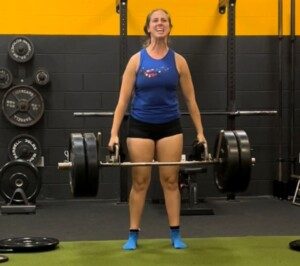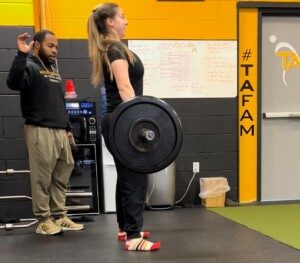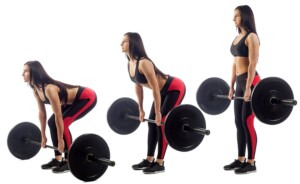Rylee was diagnosed autistic at seven.
She loves the deadlift exercise and explains how beneficial this is to her mental and emotional wellbeing.
There’s a lot of really rare things in this world.
Unfortunately, one of them is teen girls with Autism Spectrum Disorder who do the deadlift exercise.
In fact, very few even neurotypical teen girls do this amazing whole-body exercise.
Just imagine how self-assured a teen girl in today’s chaotic world would be if she could lift 240 pounds off the floor!
Rylee Howerton, 17 (as of 2023), pictured above, is one such individual. She was diagnosed with autism at age seven.
Today, she is a straight-A student and aspires to be a science teacher for the deaf.
Rylee is also a 2023 Russ Berrie Making a Difference Award Honoree.

Rylee Howerton, seated end right, with other 2023 Russ Berrie Making a Difference Award Honorees.
Amid her 4,000 hours of community service, which includes serving meals to the homeless, she has trained herself to do a hex bar deadlift of 240 pounds!
Rylee also does barbell deadlifts, currently pulling 155 pounds, which is pretty impressive for a teenage girl.

Rylee at the top portion of a hex bar lift. There are 180 pounds worth of plates on it, plus at least 45 pounds for the bar itself, making this lift at least 225 pounds.
What got her started with deadlifting in the first place?
“I played football on an all-boys full contact football team all through middle school, and I started to notice that the boys were stronger than me,” says Rylee.
“So I started to work out; shortly after, I was introduced to the deadlift.
“I saw how much weightlifting made the boys stronger, and I knew I needed to be strong so the boys would take me serious in football.
“The deadlift is something I liked because it was to prove how strong you are.”
The barbell deadlift is the exercise for which a person can lift the most amount of weight. It’s a real confidence booster.
The hex bar deadlift works the legs more than does the barbell version, but the movements are similar.
Both exercises significantly engage the middle and low back, and also work the legs, arms, shoulders and even the abs.
But these exercises aren’t just about ego. Not only does the deadlift have a massive carryover to many daily activities such as shoveling snow and picking heavy items off the floor and carrying them around, but there’s also other benefits.
“Personally, I’ve found that deadlifting has helped me emotionally, physically and mentally,” says Rylee.

Rylee locks out her barbell deadlift.
“When I deadlift it releases all of the built-up anger I’ve had for the past couple of days or even hours.
“Physically the deadlift has helped me learn how to be in touch with different muscles and learn to give attention to those muscles that I haven’t focused on.
“Mentally it has taught me how to push through these mental blocks we all get when we set personal records for ourselves.
“I think that if there are girls out there who struggle with similar problems, the deadlift can help them too.
“With deadlifting, it’s something you can set small and large goals and work at your own pace to get to them.”
If you’re a parent of an autistic teen girl (or boy), and they haven’t been introduced to the most basic of exercises – the deadlift – then ask yourself WHY NOT.
An objection by some in the autism community may be that some autistic people have physical conditions that make exercise difficult.
“Don’t judge; some of us have physical disabilities.”
I’ve heard this more than once. People with Down syndrome, an artificial leg or an artificial arm have been known to perform the barbell deadlift with substantial weight.
In fact, there are elderly women who didn’t start deadlifting until old age who can pull heavy loads.
An autistic teen or adult should never automatically make the assumption that this amazing, whole body workout is beyond their abilities. This is defeatest thinking.
An autistic person who believes “whatever comes with their autism” prevents working out with weights is depriving themselves of a conduit to fitness, vastly improved mobility and of course, a heightened self-confidence.
As a former personal trainer, I can declare with confidence that unless a person has spinal pathology such as stenosis or a bulging disc, tendonitis in an elbow, hip or knee; or continuous vertigo or another unique condition, the deadlift is safe to do as long as one uses correct form.
If in doubt, you’ll want to consider getting a full exam by a sports medicine physician and a health checkup by your primary care doctor to get the all-clearance for training with weights. You’ll get peace of mind with the all-clearance.
If one’s body is “weak” to start, they can begin using a barbell as light as 20 pounds to hone correct form.
Autism does NOT cause low muscle tone, which is a condition that some may believe contraindicates lifting weights, especially heavy.
But an autistic person, such as Rylee, may have a co-occurring condition (not caused by the autism!) that causes low muscle tone.
Rylee explains, “Along with my chromosome disorder comes many health issues.
“I had a 5% chance to live my first year and then only a 1% chance to live to see my 10th birthday. I am a miracle. And I am beating the odds every day.
“My disorder brings poor muscle tone (which is why I don’t ‘look’ strong, but I am) — and also really loose joints, so I have to be careful to not over-extend any lifting that I do.”
If your autistic teen struggles to walk smoothly or in a straight line, finds jumping on a trampoline without falling on their butt impossible, can’t catch a ball too well and/or is just generally klutzy – they can still learn to become quite strong with the deadlift.
Final word: Autism is not a deterrent to picking up barbells, hex bars, kettlebells or dumbbells and cultivating firm strong muscle tissue, strong joints and a sturdy back, and the self-assuredness that comes with all of this!
The Deadlift Does Not Require Agility
To perform the straight bar or hex bar deadlift, you stand in one spot.
There is no balancing, no funky movements, no standing on one foot.
Both feet are firmly planted during this multi-joint movement.

The deadlift. Shutterstock/Everyonephoto Studio
Though proper form is crucial (which can be learned using very light weight to start), the deadlift is a most basic, rudimentary exercise.
Autistic teens are acutely aware of their struggle to fit in and be accepted by their peers.
This burden will be a lot easier to manage if that individual knows that later on that day, they will be lifting more than their body weight, perhaps almost double their body weight, off the floor.
Any body can learn the straight bar or hex bar deadlift.
 Rylee Howerton, who was diagnosed with autism at seven, overheard other children describe her with an offensive word. This inspired her to launch the “Choose Wise Words” campaign, resulting in a children’s book of the same name (written in 2017), and opportunities to speak about kindness and inclusivity to thousands of people. As a high school student, she uses sports and pageants as a platform to share her message. She is a 2023 Russ Berrie Making a Difference Award Honoree.
Rylee Howerton, who was diagnosed with autism at seven, overheard other children describe her with an offensive word. This inspired her to launch the “Choose Wise Words” campaign, resulting in a children’s book of the same name (written in 2017), and opportunities to speak about kindness and inclusivity to thousands of people. As a high school student, she uses sports and pageants as a platform to share her message. She is a 2023 Russ Berrie Making a Difference Award Honoree.
 Lorra Garrick has been covering medical and fitness topics for many years, having written thousands of articles for print magazines and websites, including as a ghostwriter. She’s also a former ACE-certified personal trainer. In 2022 she received a diagnosis of Level 1 Autism Spectrum Disorder.
Lorra Garrick has been covering medical and fitness topics for many years, having written thousands of articles for print magazines and websites, including as a ghostwriter. She’s also a former ACE-certified personal trainer. In 2022 she received a diagnosis of Level 1 Autism Spectrum Disorder.



























